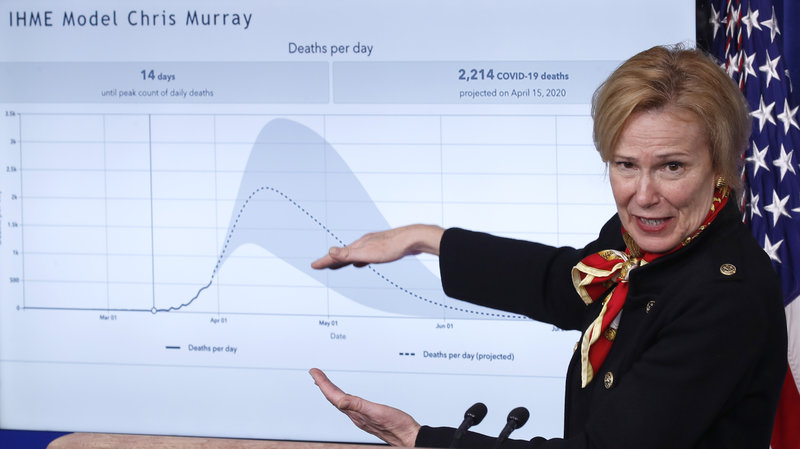Reliance on Faulty Models
In the face of a novel virus threat, China clamped down on its citizens. Academics used faulty information to build faulty models. Leaders relied on these faulty models. Dissenting views were suppressed. The media flamed fears and the world panicked.
That is the story of what may eventually be known as one of the biggest medical and economic blunders of all time. The collective failure of every Western nation, except one, to question groupthink will surely be studied by economists, doctors, and psychologists for decades to come.
To put things in perspective, the virus is now known to have an infection fatality rate for most people under 65 that is no more dangerous than driving 13 to 101 miles per day. Even by conservative estimates, the odds of COVID-19 death are roughly in line with existing baseline odds of dying in any given year.
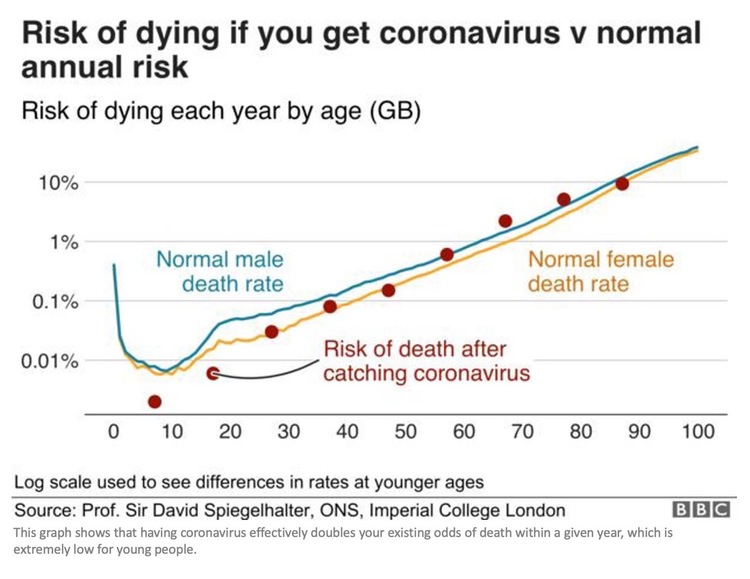
Yet we put billions of young healthy people under house arrest, stopped cancer screenings, and sunk ourselves into the worst level of unemployment since the Great Depression. This from a virus that bears a survival rate of 99.99% if you are a healthy individual under 50 years old (1, 2).
New York City reached over a 25% infection rate and yet 99.98% of all people in the city under 45 survived, making it comparable to death rates by normal accidents.
But of course the whole linchpin of the lockdown argument is that it would have been even worse without such a step. Sweden never closed down borders, primary schools, restaurants, or businesses, and never mandated masks, yet 99.998% of all their people under 60 have survived and their hospitals were never overburdened.
Why did we lock down the majority of the population who were never at significant risk? What will be the collateral damage? That is what this series will explore.
Experts took a measured approach early on
In early February the World Health Organization said that travel bans were not necessary. On Feb. 17, just a month before the first U.S. lockdown, Dr. Anthony Fauci, the longtime director of the National Institute of Allergy and Infectious Diseases said that this new strain of coronavirus possessed “just minuscule” danger to the United States. In early March the U.S. surgeon general said that “masks are NOT effective in preventing [the] general public from catching coronavirus.” As late as March 9, the day Italy started its lockdown, Dr. Fauci did not encourage cancellation of “large gatherings in a place [even if] you have community spread,” calling it “a judgment call.” NBA games were still being played.
So how did we go from such a measured tone to locking up 97% of Americans in their homes seemingly overnight?
Enter faulty assumptions and faulty models
China concealed the extent of the viral outbreak, which, if you believed its data, led many scientists to believe that 2% to 5% of all infected patients would die. This turned out to be off by a factor of 10, but academic epidemiologists have a history of wildly-off-the-mark doomsday predictions.
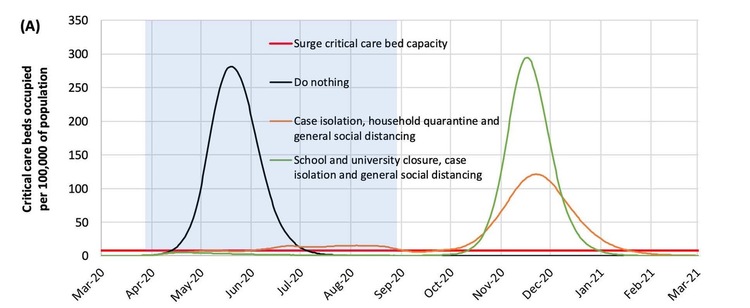
The March 16 report by Imperial College epidemiologist Neil Ferguson is credited (or blamed) with causing the U.K. to lock down and contributing to the domino effect of global lockdowns. The model has since come under intense criticism for being “totally unreliable and a buggy mess.”
This is the same Neil Ferguson who in 2005 predicted 200 million could die from the bird flu. Total deaths over the last 15 years turned out to be 455. This is the same Neil Ferguson who in 2009 predicted that 65,000 people could die in the U.K. from the swine flu. The final number ended up around 392. Now, in 2020, he predicted that 500,000 British would die from coronavirus.
His deeply flawed model led the United States to fear over 2 million deaths and was used to justify locking down nearly the entire nation. Dr. Ferguson is a character of Shakespearean drama and tragedy. His March 17 presentation to British elites on the dire need to take action ironically may have infected Boris Johnson and other top British officials, as Mr. Ferguson himself tested positive for COVID-19 two days later. Then in May he resigned in disgrace after he broke his own quarantine rules to meet clandestinely with a married woman.
But I don’t place most of the blame on people like Ferguson. If you are a hammer everything looks like a nail. I blame government leaders for failing to surround themselves with diverse viewpoints and to think critically for themselves.
Politicians claim lockdowns were the cause of fewer deaths
It would be highly embarrassing to force citizens to quarantine themselves only to later admit it was all a colossal blunder, so it is easier for politicians and modelers to claim the lower death rates were based on the lockdowns themselves. It was a success!
But several inconvenient thorns keep bursting that narrative — and none larger than Sweden, the only Western country not to lock down its citizens. Sweden never closed borders, restaurants, businesses, or primary schools. The only legal action officials took was to ban events that entail crowds larger than 50 people.
One of the most well-known and respected models in the United States is from the Institute for Health Metrics and Evaluation and is commonly cited by the White House. Since the IHME model accounts for lockdowns and social distancing, or lack thereof, they should be validated by their predictions on Sweden.
Below is a screenshot of the IHME model for Sweden taken on May 3, along with actual results (black line). The model predicted up to 2,800 daily deaths within 11 days and a final death total as high as 75,000 if Sweden didn’t enact strict social distancing measures.
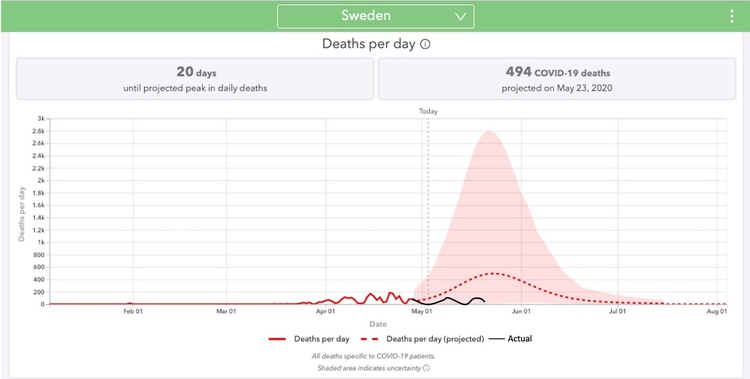
These were not complicated long-term projections; they were predicting what would happen in the next two weeks based on months of data. Yet the daily death peak was 75% lower than the baseline prediction and 96% lower than the worst-case prediction.
Not to be outdone, Uppsala University (the oldest university in Sweden) also presented a model that could have caused the Swedes to abandon course and lock down as the U.K. did. However, Sweden did not buckle. While the Uppsala University model predicted 90,000 deaths within a month, the actual result was around 3,500.
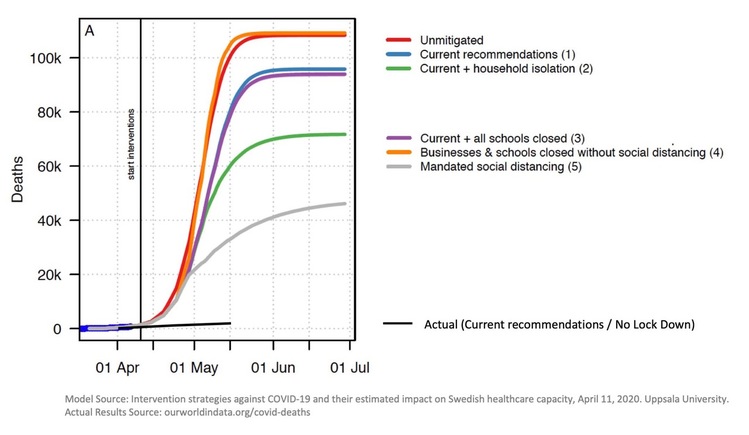
Besides deaths, there were also doomsday projections about hospital capacity, but those models also proved to be grotesquely exaggerated. On March 29, Columbia University projected a need for 136,000 hospital beds in New York City. The maximum ever used was under 12,000. At peak, New York City still had around 1 in 6 hospital beds open and around 1 in 10 ICU beds open. Hospitals had capacity, both in New York City and in Sweden.
While far below projections, Sweden’s short-term results are worse than Norway, Finland, and Denmark, but better than the U.K., France, Spain, Italy, and Belgium. Sweden likely also benefits from longer-term herd immunity, faster economic recovery, and fewer deaths from lockdown collateral damage.
Political leaders ignored early evidence when it conflicted with their models
There are those who say that we couldn’t have known these outcomes early on, so even if lockdowns were unjustified later they were still necessary early due to lack of information. That is plainly false. Italy’s alarming number of deaths fanned many of the early fears across the world, but by March 17 it was clear that the median age of Italian deaths was over 80 and that not a single person under 30 had died in that country. Furthermore, it was known that 99% of those who died had other existing illnesses.
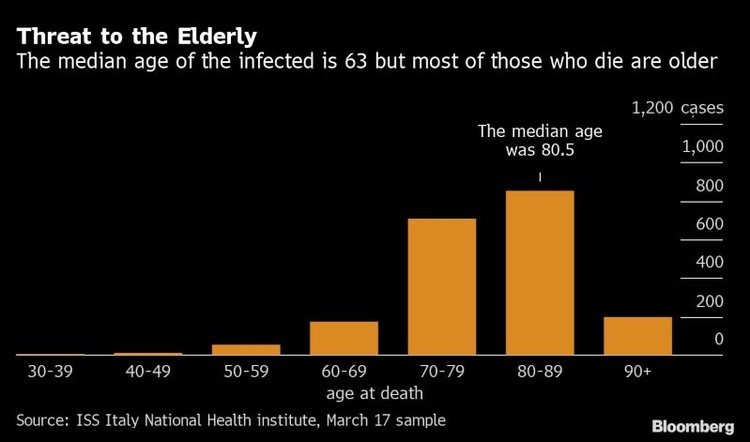
A much more rational strategy would have been to lock down nursing homes and let young healthy people out to build immunity. Instead we did the opposite, we forced nursing homes to take COVID-19 patients and locked down young people.
There are now places like Santa Clara County in California, entering its third month of lockdown despite COVID-19 patients occupying less than 2% of hospital capacity and none on ventialtors. Yet there are 2 million county residents effectively under house arrest. Some doctors and nurses in the area had their pay cut by 20% so hospitals could avoid bankruptcy, reflecting perhaps the epitome of this senseless catastrophe.
There were, of course, people warning us all along. Among them was as John P.A. Ioannidis of Stanford University School of Medicine, who ranks among the world’s 100 most-cited scientists on Google Scholar. On that pivotal day of March 17 he released an essay titled “A fiasco in the making? As the coronavirus pandemic takes hold, we are making decisions without reliable data” — but it got little attention. Mainstream media was not interested in good news stories or dissenting views. The world instead marched lock step into its man-made calamity.
This article was written by Yinon Weiss. Weiss is a tech entrepreneur, a U.S. military veteran, and a bioengineer by education.

